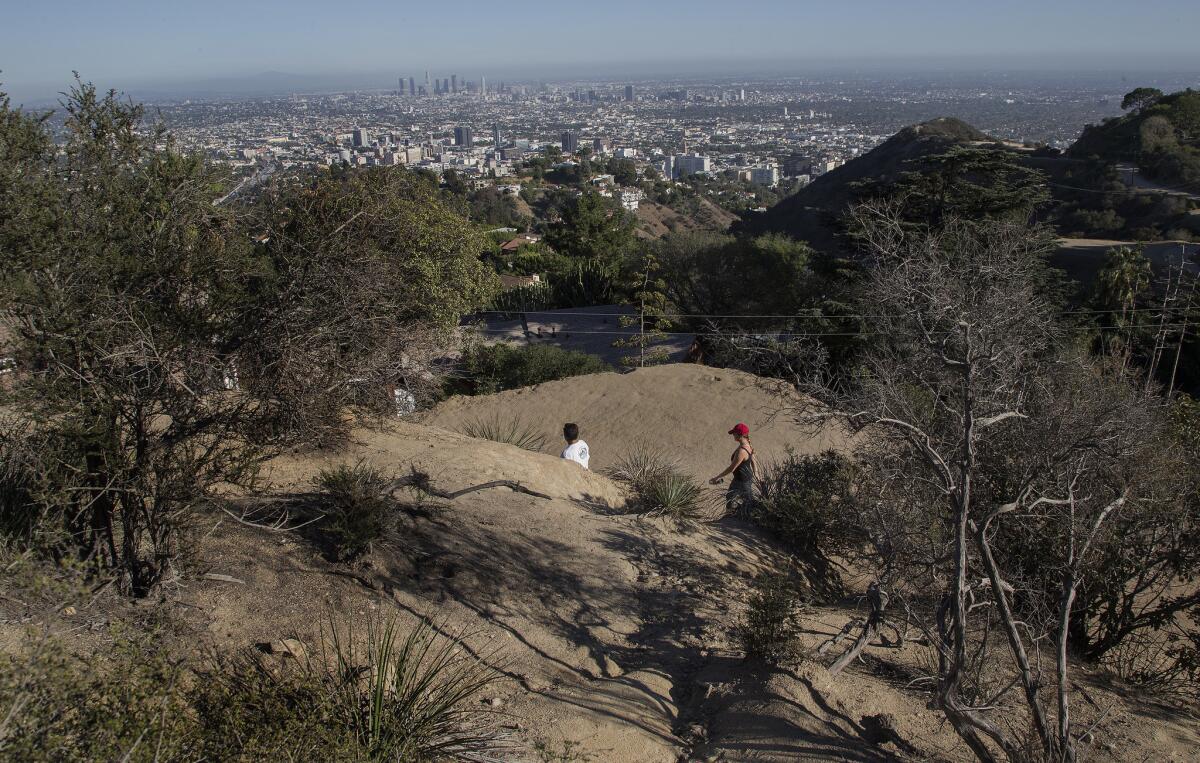L.A. hikers’ beloved Runyon Canyon is closing for four months starting in April

Runyon Canyon will be closed from April through June while the Los Angeles Department of Water and Power replaces an aging, one-mile-long pipe.
- Share via
Runyon Canyon, the popular hiking and dog-walking park in the Hollywood Hills with sweeping views of Los Angeles, will be closed for four months starting in April, city officials said.
The cause for the temporary closure is an aging 6-inch water main that stretches a mile through the park, according to the Los Angeles Department of Water and Power.
All of the 137-acre park, except for the yoga field, will be closed to the public starting April 1, when crews will begin replacing the pipeline, according to a spokesman for City Councilman David Ryu, whose district includes the park.
-----------------------------------------------------------------------------------------------------------
FOR THE RECORD
A previous version of this article said the park would be closed for three months. It will be closed for four.
-----------------------------------------------------------------------------------------------------------
Construction will run every weekday from 7 a.m. to 4 p.m., and sometimes on weekends. The park is scheduled to remain closed until July 31.
“We are just as disappointed about the park closure as you likely are,” said a statement released by the nonprofit Friends of Runyon Canyon, which lobbied to keep the yoga field open. “We are looking at this as a short-term inconvenience that will ultimately lead to a more reliable, safer park for the future.”
See the most-read stories this hour >>
Installed in the 1930s, the mile-long pipe “has deteriorated to a level that is of serious concern,” according to a report written by Joe Salaices, the superintendent of recreation and parks for the Griffith Park region. “A break in the line would probably cause major damages, not only in the park but also to properties surrounding the park.”
City officials considered keeping the park open during construction, but the repairs would have lasted up to eight months, raising costs and posing a public safety risk, they said.
“You’d have all these pipes exposed,” said Estevan Montemayor, the communications director for Ryu. “We were concerned that folks would get injured.”
The new pipe is expected to provide better fire protection and improve water quality for the park, the DWP said.
Inside the park boundaries, there have been 15 pipe leaks from 2010 to 2013, according to the most recent DWP data available. Nearly all were 6-inch steel pipes built in 1926.
A Times analysis published last year found that about one-fifth of the city’s water pipes were installed before 1931 and nearly all will reach the end of their useful lives in the next 15 years. They are responsible for nearly half of all water main leaks. Replacing 435 miles of the city’s lowest-graded pipes would cost about $1.3 billion.
The analysis found that older hillside areas such as Runyon Canyon accounted for more than a third of the utility system’s leaks from 2010 to 2014.
Experts said hilly areas usually have more leaks because of water pressure. Water agencies use pumping stations to move water uphill to reservoirs that rely on gravity for downward pressure. That force places greater stress on pipes and can lead to breaks.
On Wednesday, the City Council gave preliminary approval to the DWP’s first rate increase in four years. The utility said much of the new revenue will go toward replacing aging infrastructure.
Times staff writers Joseph Serna and Matt Stevens contributed to this report.
ALSO
In-N-Out worker slain in La Mirada not killed by gunfire, coroner finds
Protests escalate over UCLA’s handling of sexual harassment complaints against history professor
Glass slide suspended from 1,000 feet up? It’s coming to U.S. Bank Tower in downtown L.A.
More to Read
Sign up for Essential California
The most important California stories and recommendations in your inbox every morning.
You may occasionally receive promotional content from the Los Angeles Times.












